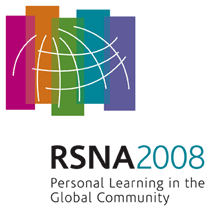
Abstract Archives of the RSNA, 2008
William W. Mayo-Smith MD, Presenter: Research support, General Electric Company
Research support, Bracco Group
Scott Collins, Abstract Co-Author: Nothing to Disclose
Jeomsoon Kim PhD, Abstract Co-Author: Nothing to Disclose
Michael David Beland MD, Abstract Co-Author: Nothing to Disclose
David J. Grand MD, Abstract Co-Author: Nothing to Disclose
David L. North MS, Abstract Co-Author: Nothing to Disclose
To measure radiation dose in a phantom with and without CT breast shields in 4, 16, and 64 detector row CT scanners using pulmonary embolism protocols.
A standard FDA-specified CT Dose Index body phantom (32 cm diameter lucite) with five ports for radiation measurements was scanned at 120 kV using our CT pulmonary embolism (CTPE) protocol, with and without the breast shield placed over the anterior portion of the phantom. The cylindrical phantom was rotated so that two ports approximated the position of breast tissue anteriorly, one was in the center and two were posterior. A pencil-type ion chamber was placed in each of the five ports of the phantom to measure x-ray exposures to the positions of the breasts, the phantom's central axis, and its dorsal surface. Each measurement was repeated three times with and without the breast shield and an f-factor of 7.8 mGy/R was used to convert exposure to dose in the lucite phantom. The experiment was performed on 4-, 16- and 64-detector row scanners. Results were tabulated and the mean attenuation at each position was calculated.
Using our MDCT pulmonary embolism protocol, the average radiation dose to the phantom at the breast locations for the 4, 16 and 64 detector row scanners without breast shields was 33.9, 25.1 and 27.0 mGy respectively. With the breast shields, the average dose was 23.3, 18.0 and 18.5 mGy respectively. The average dose reduction was 30% at the anterior phantom corresponding to the location of breast tissue, 11% at the central axis, and 0% at the posterior locations corresponding to the patient’s flank.
CT breast shields appear to reduce the breast dose by approximately 30% on 4, 16 and 64 detector row CT scanners.
Breast shields can reduce breast dose by up to 30% in MDCT PE protocols which is important given the dramatic increase in use of CT to diagnose suspected pulmonary embolism in young patients.
Mayo-Smith, W,
Collins, S,
Kim, J,
Beland, M,
Grand, D,
North, D,
Do Breast Shields Really Work? Attenuation Measurements Using a Breast Shield on 4,16, and 64 Detector Row CT Scanners. Radiological Society of North America 2008 Scientific Assembly and Annual Meeting, February 18 - February 20, 2008 ,Chicago IL.
http://archive.rsna.org/2008/6009808.html

